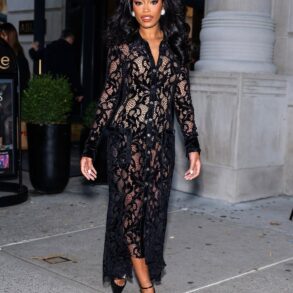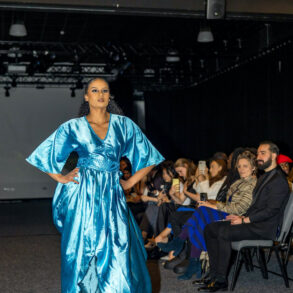Michelle Saunders stood flanked by her fellow club dance legends, Archie Burnett and Brahms “Bravo” Lafortune. They were engrossed in a lively conversation about their favorite New York clubs in the ‘70s and ‘80s. “On Saturdays, we headed downtown to the Paradise Garage,” Burnett said. Saunders’s tan face, etched with wrinkles, lit up when Burnett spoke. At the mention of the iconic nightclub, dancers slid and carved through the space behind the three legends.
They kicked their sneakers in the air, grooved and danced to the backdrop of the three voices, which were still reminiscing about the enduring community they cultivated inside the wall of Greenwich Village’s Paradise Garage.
As the three club legends talked and the dancers moved to their voices, a series of photos and videos appeared on the screen behind them. Younger images of Saunders sporting a white bikini top and short skirt flashed by, her eyes sparkling as if she were about to paint the town red with her fashionista confidence. The screen shifted to a video of a shirtless Burnett, skin ripped with muscles, as he danced around the nightclub — vogueing and waacking. Suddenly, a young Lafortune glided in, wearing two different colored shoes which blurred as he executed his signature fast footwork.
The whole spectacle took place at the University of Southern California’s Bovard Auditorium as part of Ephrat Asherie Dance (EAD)’s show “Underscored,” presented by USC’s Visions & Voices.
Hailing from New York City’s underground dance scene, these legends joined Asherie and five other members of her company, EAD, to honor club culture and the liberation it symbolizes. Club culture encompasses music, dance, fashion, social interactions and community within nightlife. It has a rich history rooted in underground metropolitan scenes.
The multimedia performance blends dance, visuals and spoken word, breaking the fourth wall and culminating in an onstage dance party with the audience. “Underscored” is more than a dance performance, it is a dynamic celebration of a culture that is too often forgotten.
Asherie, who serves as the choreographer, artistic director and performer of the company, brought these artists together to create a one-of-a-kind experience. Small in stature but big in spirit, Asherie wanted to pay tribute to the underground scene that transformed her own life. As a result, “Underscored” was born.
As a New York City b-girl, Asherie grew up surrounded by hip-hop music and culture. She went on to receive her MFA from the University of Wisconsin-Milwaukee where she dived deeply into the vernacular jazz dance roots of contemporary street and club dances. She is a 2016 Bessie Award Winner for Innovative Achievement in Dance and her choreography has received numerous awards.
The night kicked off with a pre-show panel which consisted of hip-hop icons in the Los Angeles dance scene. Soul Train dancers Bill “Slim the Robot” Williams and Sharon Hill were joined by Toni Basil, Deidra “Krucial” and Charlie E. Schmidt. Together they discussed the creation of unique West Coast hip-hop dances in influential L.A. clubs — movement labs where the scene’s hottest dancers gathered to experiment and innovate. Spanning five generations, the panelists provided context for the hour-long show that followed.
The lights dimmed as figures slinked across the back of the stage, their bodies only visible as silhouettes. Facing the back, one by one they freestyled hip-hop to the synth music. As the bass gradually intensified, the dancers’ movements grew more energetic. It culminated in an eruption of music, light and dance that engulfed the stage.
At certain points in the show, the six people danced in unison, but it was their freestyles that showcased their distinct movement styles. Matthew “Megawatt” West defied gravity with his breakdancing, while Manon Bal fiercely vogued and framed her face with sharp wrist movements and poses. But after ten minutes, the company humbly took a backseat when the legends arrived on the scene.
Not even Saunders’ neon green hair could outshine her smile as she strutted out from the corner wing. At 80 years old, she danced through the corridor of bodies and lightly tapped the company members as she went. With her touch, each performer peeled away into a groovy house dance sequence.
Within this scene, Saunders embodied the spirit of the Paradise Garage and similar clubs that thrived at the time. Even with her more limited movement range, her unabashed dedication to dance and music as a means of self-expression was unmistakable.
As Saunders gracefully exited, large square mirrors rolled onstage. People craned to get a look at who was hidden behind them, but the mystery was short-lived.
Burnett burst forward with captivating confidence. He moved his long arms in his iconic vogue style and he sliced his limbs in precise lines. Even the slightest hip roll or finger flick drew enthusiastic cheers from the audience.
But Burnett’s solo was more than just a dance. “How long do you think our club hours were?” he gazed out into the auditorium and asked. In response, someone from the audience shouted, “9 pm to 2 am,” to which Burnett threw his head back and laughed. “Sundown to sunup,” Burnett declared after a few more wild guesses.
Last but certainly not least, Lafortune joined Burnett. Known for his unmatchable house footwork, he wasted no time getting into the rhythm. Asherie and the company often circled these dance legends, sometimes they joined in the dance and other times allowed them to command the stage.
Interwoven with the freestyle and house beats were monologues and conversations between the performers, who reminisced about their cherished dance havens. Lafortune shared anecdotes about David Mancuso’s iconic club and The Loft. The younger performers recounted their experiences at various dance spaces. It all made for a beautiful exchange of intergenerational wisdom. All the performers were united by their shared experiences as artists who found their voices by dancing in nightclubs. They were surrounded by the safety of like-minded individuals who were there to deeply feel the music and connect with their communities.
“Underscored” did more than just tell its viewers about the New York City clubs. It delved deep into the memories which resided within Saunders, Lafortune and Burnett’s minds. They were brought to life and recreated with an end-of-show dance party on the Bovard Auditorium stage. Followed by their bows, the performers leaped off the stage and invited audience members to join them. The LA dance community intermixed with the legends and old friends from opposite coasts reunited. Eventually, Burnett found himself at the center of the onstage dance circle, then gestured for others to join him in the spotlight.
Although the vibrant underground club culture from the 1970s to the 1990s may only now exist in memory, there will always be cultural pockets preserving its legacy. “Underscored,” through its engaging history lesson, paid tribute to the pioneers who played a significant role in shaping the hip-hop culture we know today. While many of these club legends have since passed away, Asherie’s work ensures that their contributions are remembered and celebrated.





